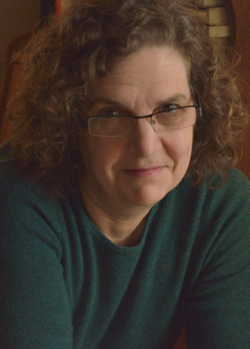Framing the Camera Lens: Christine Leclerc in Conversation with Anne Marie Todkill

Malahat volunteer Christine Leclerc talks with our 2016 Novella Contest winner, Anne Marie Todkill, whose story "Next of Kin" was chosen for the $1,500 prize.
The contest judges Mark Anthony Jarman, Stephen Marche, and Joan Thomas had high praises for Todkill's story: "With its controlled reveal of complications, it has the drive of a mystery story—but the mystery under investigation is the intricacies of a family over time."
See the original 2016 Novella Prize winner announcement page.
Such a number of narrative threads run through “Next of Kin.” Did Marian emerge immediately as the obvious narrator and main character?
As far as I remember, Liz’s character came to me first, but I always saw her through the lens of another character—a daughter—who eventually became Marian. If Liz was the originating spark, some version of Marian was always the medium as the first-person narrator. And once you give your narrator the “I,” she’s in the protagonist’s seat—unless you’re doing something particularly clever with narrative framing. At any rate, Marian’s point of view prevailed, and that brought a particular focus.
In a coming-of-age story, it’s common for the main character to negotiate power in many areas of life at once. Marian’s transition to adulthood is also strewn with personal tragedy and disappointment. How did this story’s ending reveal itself? And likewise, how did the major scenes come into focus?
This piece simmered on the back burner for so long that I don’t think I could reconstruct the process very reliably. But, basically, various scenes and events surfaced at different times. It all seemed like a series of false starts, but eventually I saw connections between different elements. Sometimes I wrote dialogue to see what would come out of characters’ mouths—the process is similar to improvisation in theatre—and then worked with sequences that seemed right. I guess the trick is to let things bubble up, see what happens, and then decide which episodes or reflections really belong to this story, and what is still missing.
Eventually, you have to interrogate all this free association: What is this image doing here? What is this character’s recollection really about? If nothing unexpected comes up, it’s boring for the reader. It’s also boring for the writer. Vera’s character blew into my mind one day; I’m not sure what triggered her appearance, but she stuck around. So then I had a relationship between Vera and Liz to work with, and one between Vera and Marian. I started thinking about Vera’s backstory, which raised questions about how her story should be revealed, to whom, and by whom, and this led more or less organically to the closing of the story.
A favourite passage reads: “Mrs. Curran sat on a vinyl-and-chrome chair behind the counter, not saying much and sucking her teeth as if she were testing her dentures or else mulling over some dark speculation about me. She always had an expression like she was looking at you from a distance, like you were from somewhere far off, somewhere strange. I used to invent scenes in which Vera would blow in and give her something to think about. The problem was that she and Mrs. Curran didn’t belong to the same plot.” Will you tell us about the meta-fictional elements of this story?
My sense is that most people—not just literary theorists—take this “meta” perspective from time to time. People often reflect on how their lives and other people’s have “turned out.” And most of us are thrown, at some time or another, by feelings of powerlessness, or a disconnect between expectation and reality, or between one set of circumstances and the next. Sometimes our good luck, or bad, makes us incredulous, as in “How can this be happening to me?”
I see Marian, at her stage of life, as being especially self-conscious about how others might size up her “small life”; feeling arbitrarily dislocated, she wonders how to fit in and worries about how others perceive her. She longs to tweak the plot, to find a way for things to become more glamorous, romantic, exciting, or whatever. And, of course, she envies her sister, who seems to be having better luck in determining the course of her life. At another point Vera remarks on how Liz wanted her girls to “stick to the script” —a commonplace, clichéd remark, but it does speak to the perennial tension between generations with respect to acceptable story-lines.
The thing is, though, that both generations of women in the story have to grapple with the kind of narrative they can write for themselves within the social constraints of their time. Vera knows what can happen when you don’t stick to the script.
Did writing this story reveal anything about grief to you?
[In this story] everyone has his or her own strategies for surviving grief; Marian copes by propping up her mother; Ruth moves forward by sticking to her plans; Liz disappears into her grief and can’t see over the top. Vera is the one who models generosity in grief. Whether or not sorrow genuinely brings any of the characters closer to one another, it does seem to strengthen their loyalties a little, which isn’t nothing.
A strong sense of the world and possibilities of southern Ontario come through. Will you tell us about the role of history in building up a sense of place? Are there other strategies used to help transport the reader?
The characters came to me very much attached to a particular social milieu that contained within it, after the recent experience of war, a longing for stability and safety, even though the younger generation would soon tumble through the social transformation of the sixties and beyond. The urban/rural divide in the story speaks to the nostalgic dimension of that longing, I think.
In the sixties, moving to the suburbs was a common middle-class aspiration; Liz takes this a step further with her romantic notions about country life, which she manages to wrap up in career ambitions. But although I see the characters as inhabiting, and being inhabited by, a particular socio cultural moment, and their interpersonal tensions as arising from the character of that time, I tried to get at this largely through synecdoche: a world war is reduced to the fragment of a song; the “sexual revolution” is emblemized by the pill.
When I was thinking about your question, a standard lesson in photography how-to books came to mind: that thing where a sequence of photos is used to show the effect of different focal lengths. So, for example, a portrait lens might frame the tourist’s face against a patch of sky; a standard snapshot lens would reveal that the tourist is in fact standing beside a statue; and a wide-angle lens would show the tourist, the statue, and a crowded streetscape. It’s the same person in every image, but each framing makes us consider more, or less, of the context. I wanted to situate the characters concretely in a specific time, but I didn’t want the historical setting to become the subject.
So we don’t have here the CinemaScope or Panavision of capital-H history. On the other hand, the question of whether history-as-epic and history-as-biography can really be separated could keep us occupied for days. Come to think of it, an acute awareness of “the personal as political” was entering the discourse of feminism during the period in which I situate Marian and Ruth as young women. That discourse has been evolving ever since.

Christine Leclerc
* * * * * * * *









